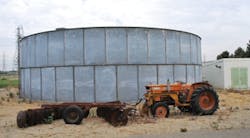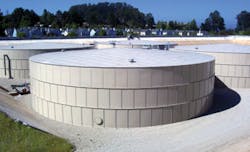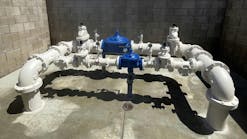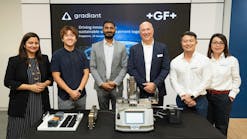By Brandon Alexander
Many people are familiar with bolted steel tanks and how they save time and money. Bolted storage tanks have been used for many decades, and some older tanks are still in use today. However, most people do not realize the numerous advances in bolted steel tank design and construction that have occurred over the past several decades.
Modern bolted steel tanks are quite different than those from 40 years ago, and the distinctions begin during the design process. Older tanks were drawn in two dimensions, which was very time consuming, and some drawings were not properly prepared, making it difficult to fabricate the tank. New bolted steel tanks, however, are designed using 3D modeling software, making the process considerably faster and more accurate.
Some premium tanks are designed using the simplified building information modeling (BIM) software, which encompasses the entire project from engineering to manufacturing and construction. Additional information can be contained within the BIM system, including weights and dimensions of materials and components used to construct the tank. Current design standards such as AWWA D103 have progressed over time, resulting in tanks that last longer and perform better. In addition, advances in seismic and wind design methods have led to safer and more structurally sound tanks.
Customer approval of drawings is also considerably faster, as engineering drawings can be sent electronically instead of mailed as hard copies. If a change to a tank accessory is needed, the 3D modeling system makes the revision very simple and accurate.
A second major difference between older tanks and modern bolted steel tanks is how they are manufactured. Older tanks were constructed of material that was individually fabricated by hand or with basic equipment. The slight variations in the process or differences in how parts were measured resulted in parts not fitting properly, which led to leaks. Modern tanks are precision-crafted in state-of-the-art factories with specialized machinery. Tank drawings and details are exported from the 3D modeling software into sophisticated computer-aided manufacturing programs that directly control the CNC machinery. Further, the automated process reduces the fabrication time and ensures accuracy. To ensure that steel panels are fabricated to exact measurements, the entire panel is locked into place within the machinery to prevent the panel from shifting during forming. Tank components are also welded together using robotic welding equipment for extreme accuracy and 100-percent perfect joints.
In addition, numerous procedures have been implemented to ensure that all aspects of manufacturing are extremely accurate. Select tank manufacturing facilities are ISO 9001:2008 certified, guaranteeing product consistency and quality. These companies have invested time and effort into solidifying the way operations perform to eliminate errors and improve quality. All aspects of engineering, manufacturing and shipping processes are analyzed to ensure the customer receives exactly the product they ordered. The ISO process is so comprehensive that even measuring tools such as tape measures and calipers are officially certified to be accurate.
Another significant advancement with modern bolted steel tanks is the availability of new tank finishes. Innovative new options such as powder coating have significantly increased the longevity of bolted steel tanks. The thermoset powder coating process requires careful preparation and application for greatest durability. Steel panels are first cleaned and prepared using standards from the Society for Protective Coatings (SSPC) and the National Association of Corrosion Engineers (NACE) to ensure maximum coating adhesion. To further improve the durability and longevity of the tank powder coating, a special silica-zirconium (SiZr) liquid seal is sprayed onto the prepared steel panels before the powder coating is applied. The SiZr seal is designed to prevent the spread of corrosion if the coating is damaged by impact.
The zirconium component increases the adhesion of the powder coating to the steel panel and has been used for decades in similar applications. The silica in the SiZr seal blocks the steel oxidation process, reducing the amount of corrosion; without the seal, undercutting can occur, increasing the amount of coating damage. Laboratory tests have shown that the SiZr seal isolates the corrosion to a small area and can make the difference between a minor coating patch and a significant coating renovation. After the seal dries on the steel, the powder coating is electrostatically applied to steel panels and other components in an environmentally controlled area. During the application process, a small static charge is used to hold the particles of powder to the steel panels until they are heated and cured. The charge ensures that the powder coating forms a smooth, even surface without voids or thin spots.
For the interior of the tank, an epoxy powder coating specifically designed for continuous emersion is used. For potable water storage, the interior epoxy coating must be NSF 61 certified. For maximum resistance to ultraviolet exposure and harsh weather conditions, a triglycidylisocyanurate (TGIC) polyester powder is then applied to the exterior of the steel panels. Directly after application, the powder coating is heat-cured in special ovens, and the panel surface is completely sealed. This thermoset process heats the powder coating to the point that it begins to melt then chemically reacts to form a higher molecular weight polymer that permanently bonds to the steel surface.
All panels and structural components such as roof rafters and appurtenances are powder coated on all sides, and therefore the entire tank, including inaccessible areas such as the underside of the tank bottom, are entirely protected against corrosion. The powder coating remains flexible after curing, allowing the coating to move with the expansion and contraction caused by temperature change; the coating will not shatter if impacted. An additional coating option is glass lining, which consists of minerals sprayed onto the steel panels that are then subjected to very high heat to melt the minerals and form glass. The glass lining is non-porous, but extreme caution must be taken to not damage the lining, as undercutting or corrosion can occur.
Hardware has also improved since bolted tanks were first put into service. To ensure maximum longevity of the tank, various nut and bolt types are available. Encapsulated nuts and bolts are best suited for specific applications and protect against hardware corrosion. The composite encapsulation material prevents the liquid from directly contacting the steel of the nuts and bolts. In other applications, hot-dipped galvanized nuts and bolts are the best alternative to prevent corrosion. Rubber-backed washers can also provide additional protection against leaks. In addition, the strength of the hardware has increased, and bolts used today will have a tensile strength of over 120,000 pounds per square inch. Modern bolted steel tanks use Grade-5 and Grade-8 bolts versus older tanks, which employed Grade-2 hardware. Advances in tank design, manufacturing processes and materials allow modern bolted steel tanks up to 3.5 million gallons to be constructed.
A final significant improvement in bolted steel tank design and construction is the heavy-duty synthetic gasket material used in place of putty mastic. New gaskets are constructed of durable ethylene propylene diene monomer (EPDM), Buna N or Viton, and each material is specifically intended for storage of a different liquid. EPDM is very well-suited for continuous use with water and will resist even corrosive brine water, and gaskets made of Buna N or Viton are ideal for storing oil and other petrochemicals. Buna N and Viton gasket materials have been used for decades in oil pumps and valves.
The tank gaskets are precisely fabricated to fit into the seam between the steel tank panels and provide decades of leak-free service. Gaskets are solid strips perforated to the specific bolting pattern of the tank and will not slip out of place or ooze over time. The holes in the gaskets are intentionally slightly smaller than the bolts, which eliminates any gap between the gasket and the bolts. The gaskets are under compression and remain flexible and are therefore able to prevent leaks, even as the steel expands and contracts due to temperature fluctuations and seismic movement. The gaskets are able to flex slightly and absorb tank movements, ultimately reducing stress on the steel joints. Premium quality gaskets have a long lifecycle when properly fitted and do not need periodic replacement.
Most bolted steel tank manufacturers use these new technologies and processes, but not all companies do. Therefore, it is important to verify these details with your tank manufacturer before making a purchase. When implemented properly, these advances can result in a superior quality bolted steel tank with one of the lowest maintenance requirements and one of the longest lifespans of all tank types.
About the Author: Brandon Alexander currently serves as marketing coordinator for Superior Tank Co., Inc., located in Southern California. Alexander has worked in heavy manufacturing and construction since 2000 with projects ranging up to $20 million. Superior Tank manufactures and erects bolted steel tanks throughout the U.S., Mexico and Canada, and its kits have also been shipped to countries throughout the world.
More WaterWorld Current Issue Articles
More WaterWorld Archives Issue Articles




